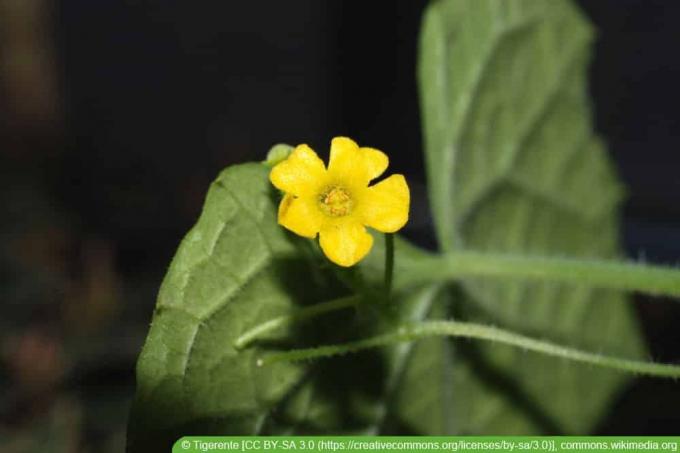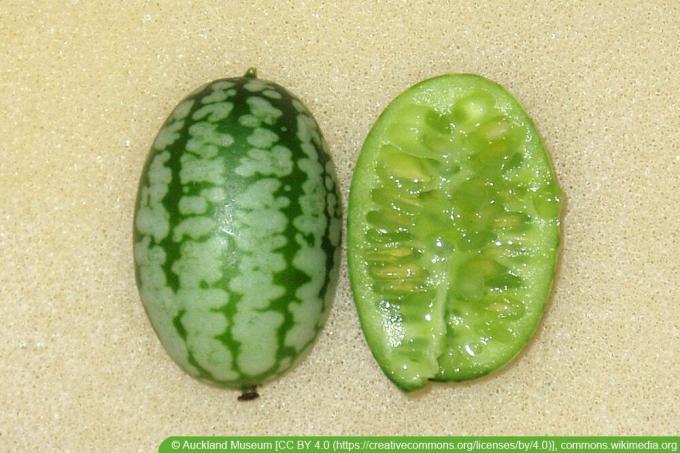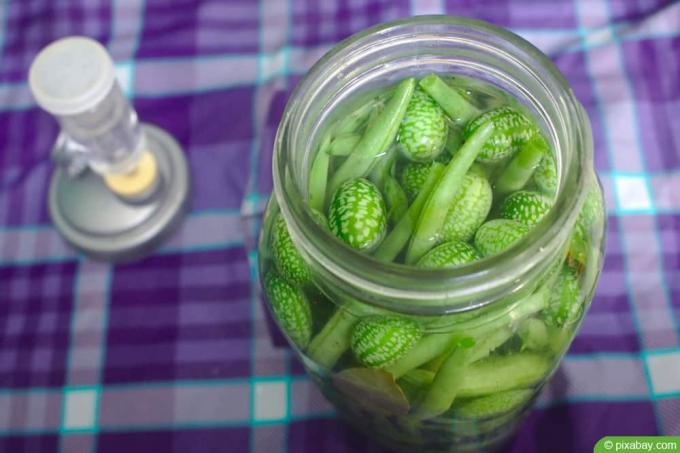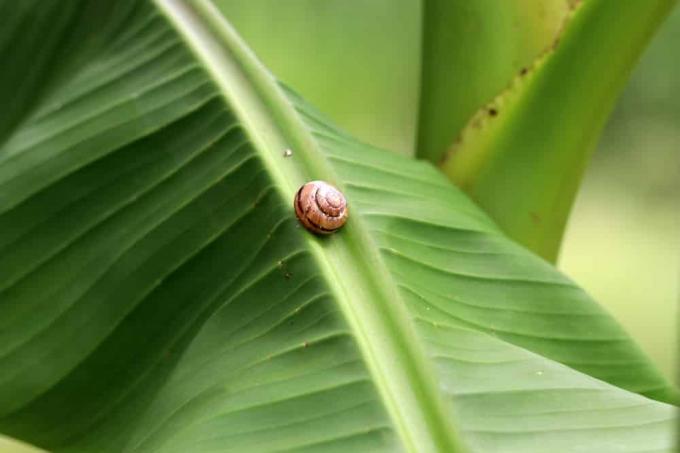

Table of contents
- Characteristics
- sowing
- material requirements
- method
- Location
- plants in the bucket
- Pour
- Fertilize
- Cut
- hibernate
- multiply
- diseases and pests
With bite-sized, distinctively striped fruit, the Mexican mini cucumber puts a smile on our faces. The tropical climbing plant inspires with rapid growth towards the sky and provides refreshing snacks in the midst of summertime. On the way there, distinctive yellow flowers adorn the picturesque pumpkin plant with the decorative, seductively fragrant foliage. Its diverse advantages make up for the fact that Melothria scabra is not hardy in local regions. Read all the information about professional care from A to Z in this guide.
Characteristics
- Plant Family: Cucurbitaceae
- Popular species within the genus Melothria
- Name of the species: Mexican mini cucumber (Melothria scabra)
- Common names: bryony, cucumber melon
- Origin: tropical regions of Central and South America
- Growth: herbaceous climbing plant up to 200 cm tall
- Root system: tuber
- Flowers: yellow, 5-8 mm small, bell-shaped flowers in May/June
- Foliage: heart-shaped, lobed, with a slight musky scent
- Fruits: uniform, 1.5-3.5 cm long, striped green
- Hardy: no
The name refers to the taste of the tiny fruit, which looks like mini watermelons. Fresh from the bush or deliciously pickled, the berries spoil the palate with the refreshing aroma of sweet and sour cucumbers. The following care instructions explain in detail how easy it is for hobby gardeners to enjoy freshly harvested delicious Mexican mini cucumbers.
sowing
There are solid arguments for growing behind glass. Mexican mini cucumbers are not prepared for freezing temperatures. The time window for direct sowing in the bed opens in mid/end of May at the earliest. By sowing the seeds under sheltered conditions, you extend the cultivation time by a whopping four weeks. Furthermore, early Melothria scabra start the season with a vital growth advantage in favor of vigor and crop yield. This is how sowing succeeds in an exemplary manner:
material requirements
- heated indoor greenhouse
- Cultivation pots (ideally 12 cm) with an opening in the bottom for water drainage
- Substrate: Mixture of sifted compost and sand in equal parts or commercial potting soil
- Wooden stick or round trellis/perennial support/flower holder
You cannot see from the substrate whether pathogenic agents are hiding in it. It is therefore advisable to disinfect potting soil before use. You can do this in a fireproof bowl with a loosely fitted lid. Moisten the soil slightly and put it in the oven for 30 minutes at around 100 degrees.
method
Fill the disinfected, cooled substrate into the growing pots. Moisten the soil with a fine spray until the first drops run out at the bottom. Sow 2 to 4 seeds per pot. Sieve the seeds in seed strength and press the substrate lightly for a good soil contact. Now place the pots in the indoor greenhouse in a partially shaded location. At constant temperatures between 20 and 25 degrees Celsius, germination takes 8 to 14 days.

Ventilate the indoor greenhouse regularly and check whether the substrate is slightly damp. After emergence, lower the temperature to 18 to 20 degrees Celsius or place the pots on the bright window sill in the heated living room. If the growing pot is cramped, choose the most promising Mexican mini cucumber. Tie the tendrils to the support pole or climbing aid so they don't lie on the ground.
Sowing and growing in one pot saves you and your mini cucumber the stressful, risky procedure of transplanting. Several seeds are sown per nursery pot so that you can select the strongest specimen after germination and sort out weak seedlings. By the middle/end of May, your favorite will have developed into a vital young plant that you can transplant into a bed or container without fearing damage to the root system.
Location
A sunny, warm and wind-protected location contributes significantly to the fact that Mexican mini cucumbers have a rich harvest. For the bulbous root system, the climbing beauties want well-drained, humus-rich and nutrient-rich garden soil. The soil should be fresh to slightly damp, beyond the risk of waterlogging. Cultivation in a container is under a lucky star if you use peat-free container plant substrate or organic vegetable soil.
plants in the bed
After the ice saints in mid-May, the planting season for Melothria scabra outdoors begins. Prepare a weed-free, finely crumbly potting soil at the chosen location. Meanwhile, place the still potted, young mini cucumbers with the root ball in soft water. How to proceed:
- Dig small pits 30 to 40 cm apart
- Mix the excavation with a handful of horn shavings and some sifted compost
- Pot the Mexican mini cucumber with the trellis
- plant in the bed soil while maintaining the previous planting depth
- Press and water the soil
Experience has shown that the climbing aid during the propagation phase is not sufficient for further rapid growth. After planting, mount appropriately high support brackets in the bed. Even a simple rack of wooden sticks is enough for a Mexican mini cucumber to thrive in the right direction. Detach the tendrils from the previous climbing aid and tie them to the final climbing scaffold.
Tip:
Mexican mini cucumbers with juicy leaves are very popular with gluttonous snails and other uninvited guests. Protect Melothria scabra that have been planted out with a close-meshed net that you stretch over the bed without gaps.
plants in the bucket
A suitable bucket for the Mexican mini cucumber is at least 20 centimeters high with a diameter of 30 centimeters and a volume of 10 liters. Please choose a bright vessel that reflects the sun's rays in full sun. In dark pots, there is a risk of root damage if the soil heats up too much. It is important to have at least one opening in the bottom so that excess water can drain off. Furthermore, a climbing aid should already be integrated in the form of a pyramid or a trellis. Alternatively, cultivate a Melothria scabra in the hanging basket. This is how you properly plant Melothria scabra that you have grown yourself or bought ready-made:
- Place a curved potsherd over the water drain as drainage
- Fill in the substrate up to a pouring edge of 5 cm
- Dig a small hollow in the middle for the root ball
- Repot the watered young plant and plant as deep as in the seed pot
Press the soil down with both hands to ensure complete contact between the root ball and the substrate. Finally, water until the first drops of water run out of the bottom opening.
Pour
Parallel to the progress of growth, the water requirement of a Mexican mini cucumber increases. The sunnier the location, the higher the temperatures and the denser the foliage, the more often the plant needs to be watered. In the height of summer, it's common practice to water a majestic cucumber melon early in the morning and again in the evenings. Before that, a simple thumb test determines whether there is an actual need for watering. How to do it right:
- Press thumb or forefinger 1 cm deep into the substrate
- do not water when there is noticeable moisture (there is a risk of harmful waterlogging)
- Water if no moisture can be felt
- let well stale water run out of the jug spout directly onto the root disk

Do not water a Mexican mini cucumber over the leaves and flowers. Damp leaves and wet flowers offer pathogens and pests an ideal target. Please do not treat the exotic climbing artist with ice-cold, hard tap water. Ideally, use collected rainwater for the water supply. Alternatively, leave the irrigation water in the pot for a while so that the lime content drops.
Fertilize
As fast-growing climbers, Melothria scabra have considerable nutrient requirements. To ensure that growth, flowering and fruit yield do not falter, regularly replenish used energy reserves. For this purpose, add a liquid organic vegetable fertilizer to the irrigation water weekly. Start giving liquid fertilizer about four weeks after planting in the bed or tub. From this point on, the nutrient reserves in the substrate are used up.
Cut
The Mexican mini cucumber tolerates pruning well. You can cut off annoying tendrils at any time. If the offending shoots have promising flowers or even fruit, check before cutting whether it is possible to deflect them on the trellis. Otherwise, use the scissors to deprive yourself of the pleasure of delicious mini cucumbers.
hibernate
The sensitivity to frost hides the fact that Mexican mini cucumbers thrive for several years. In fact, the vigorous climbing plants are notorious as weeds in their native ranges. The vitality of a perennial rests in every root bulb, provided it is protected from temperatures below freezing. How to properly overwinter a tropical cucumber melon:
- Hibernation when the temperature falls permanently below 10 degrees Celsius
- Detach the tendrils from the climbing aid and cut off except for a short stub
- Dig up root nodules
- Remove soil by hand or with a soft brush
- Lay the tubers out to dry on old newspaper in a cool, rain-protected, shady place
The root bulbs are ready for moving to winter quarters when they are no longer damp. Comparable to dahlias, you can stack the tubers in wooden boxes to save space. Newspaper, cardboard, sawdust and sand are suitable as intermediate layers. Points of contact between the individual tubers should be avoided because there is a risk of mold and rot developing if there is direct contact. Please place the hibernation box in a dark and dry place at temperatures of 5 to 8 degrees Celsius. A basement room away from the heating and laundry room is well suited. Alternatively, wrap each bulb in newspaper, stack the packets in a breathable cotton sack and hang from the ceiling of the airy attic.
Tip:
Leave a few mini cucumbers hanging from the plant. In conjunction with wintering, pick the fully mature fruit, which now contains numerous, flat, oval seeds within the pulp. Dried and stored in a dark screw-top jar, you have valuable seeds in your hands for sowing next year at no cost.
multiply
For the propagation of Melothria scabra you have the choice between the generative method of sowing and cultivation behind glass, as explained at the beginning of these instructions. Ripe seeds are contained in large numbers in mini cucumbers and can be easily separated from the pulp. Alternatively, resort to vegetative propagation by digging up the tubers in the fall and overwintering, as detailed in this guide. In May, you wake up the storage organs from their hibernation. With a sharp knife, cut each tuber into segments with at least one bud as a growing point. Plant the sections in a sunny bed or a large bucket at a distance of 30 to 40 centimetres.
diseases and pests

You will rarely have to complain about diseases and pests on Mexican mini cucumbers. However, the exotic fruit vegetable is not completely immune. Constantly damp summer weather or watering over the leaves brings fungal spores onto the scene. If a mealy-grey coating spreads out on the foliage, cut off infected parts of the plant. Spray the entire plant repeatedly with a 5:1 mix of lime-free water and fresh milk.
If the leaves curl up, are covered in spots or dry up from the edges, the plant suffers from a massive aphid infestation. With a tried-and-tested home remedy, you can fight the bold pests without impairing the eating quality of the fruit. You can make an effective organic insecticide from 1 liter of soft water and 30 grams of liquid curd soap. Spray the infested Mexican Mini Cucumber every 3 days until no more infestation symptoms appear.
 Home editorial office
Home editorial office
Learn more about Exotic Fruits

Lulo, Solanum quitoense: Care of the Quitorange from A to Z
Lulo, Solanum quitoense or Quitorange - the South American plant and its fruits are in this country almost unknown but have some advantages both as an ornamental plant and as a fruit-bearing shrub offer. All details from care to effect can be found here.

Growing watermelons: how to grow melons yourself
Watermelons are extremely heat-loving plants, but with a few tricks they can also be cultivated in the home regions and cultivated successfully. The site conditions and care play an important role. If these factors are right, the harvest of juicy melons will be plentiful.

Zierbanane, Musa Banana - care and instructions for wintering
With its majestic shape, the ornamental banana is a welcome guest in conservatories and imaginatively designed living spaces. The tropical Musa Banana looks gorgeous in a bucket on a summery balcony. This guide provides you with detailed information about the right care and provides well-founded instructions for overwintering the tropical beauty of plants.

Planting an avocado seed – this is how you grow an avocado tree
Avocados are already a delicacy in the local kitchen and it is hard to imagine life without them. But the plant is also becoming increasingly popular in the local latitudes in tubs as a houseplant. So if you still have seeds left after processing, you can plant them.

Growing Sharon fruit - how to grow persimmon plants from seed
The Sharon fruit, also known as the persimmon tree, is not yet widespread in the local latitudes. As a rule, the tree is cultivated here in a bucket because it is not hardy. The seeds of the fruit are now also being offered more and more frequently for your own cultivation.

Avocado, Persea americana: profile and nutritional values - is it healthy?
For a long time, the avocado was spurned as a calorie bomb. Today, the green fruit has established itself as a superfood and is experiencing a boom. Is Persea americana healthy or not? This profile and a look at the nutritional values shed light on the darkness.


